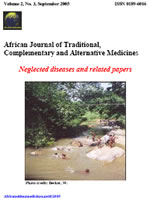
|
African Journal of Traditional, Complementary and Alternative Medicines
African Ethnomedicines Network
ISSN: 0189-6016
Vol. 14, No. 5, 2017, pp. 104-112
|
 Bioline Code: tc17064
Bioline Code: tc17064
Full paper language: English
Document type: Research Article
Document available free of charge
|
|
|
African Journal of Traditional, Complementary and Alternative Medicines, Vol. 14, No. 5, 2017, pp. 104-112
| en |
PROTECTIVE EFFECT OF CAMELLIA OLEIFERA  ABEL. ON SILICA-INDUCED PULMONARY FIBROSIS IN RATS ABEL. ON SILICA-INDUCED PULMONARY FIBROSIS IN RATS
Tian, Shenglan; Liu, Xiaoliu; Yang, Yang & Lv, Yang
Abstract
Background: Camellia oleifera Abel. belongs to the family Theaceae and genus Camellia. It is commonly cultivated
in southern China. The seeds of C. oleifera have been reported to exhibit a diversity of pharmacological activities
which include, but are not limited to, antioxidant, anti-cancer and antimicrobial. Pulmonary fibrosis is one of lethal
causes of mortality across the globe and accretion of considerable amount of reactive oxygen species (ROS) in lungs
have been implicated in the onset of this disease. Given the known antioxidant activity of C. oleifera seed extract
(CSE), the present study was designed to evaluate the influence of CSE on the silica-induced pulmonary fibrosis rat
models.
Materials and
Methods: Protective effect of CSE was determined in silica-induced pulmonary fibrosis rat models.
Malondialdehyde (MDA), hydroxyproline (HP) and superoxide dismutase 2 (SOD-2) activity were determined by
standard biochemical assays. Histopathological analysis was carried out by H and E staining. Phyto-constituents of
CSE were identified by LC/MS analysis.
Results: The results of this study indicated that CSE lowered the MDA and hydroxyproline content in silica-treated
rats. Additionally, CSE also caused a significant increase in the expression of SOD-2 leading to scavenging of ROS.
Hematoxylin and eosin (H and E) staining of lung tissue sections revealed that CSE maintained the integrity of
parenchymatous cells of lungs and prevented the development of pulmonary fibrosis. To gain insights about the
phytochemical constituents of CSE, LC/MS analysis was carried out and several antioxidant phenolics and flavonoids
were tentatively identified.
Conclusion: Taken together, we conclude that CSE prevents development of pulmonary fibrosis and the protective
effect of CSE may be due to its ability to induce SOD-2 expression and due to the presence antioxidant phyto-constituents.
Keywords
Pulmonary fibrosis; Silica; Camellia oleifera; Reactive oxygen species; Superoxide dismutase.
|
| |
© Copyright 2017 - African Journal of Traditional, Complementary and Alternative Medicines
Alternative site location: http://journals.sfu.ca/africanem/index.php/ajtcam
|
|
